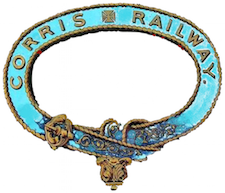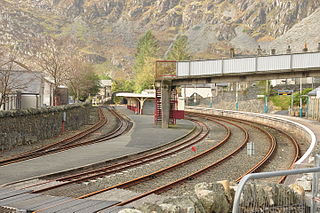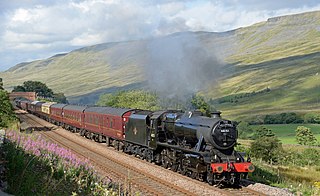
The Corris Railway is a narrow gauge preserved railway based in Corris on the border between Merionethshire and Montgomeryshire in Mid-Wales.

The National Railway Museum is a museum in York forming part of the Science Museum Group. The museum tells the story of rail transport in Britain and its impact on society. It is the home of the national collection of historically significant railway vehicles such as Mallard, Stirling Single, Duchess of Hamilton and a Japanese bullet train. In addition, the National Railway Museum holds a diverse collection of other objects, from a household recipe book used in George Stephenson's house to film showing a "never-stop railway" developed for the British Empire Exhibition. It has won many awards, including the European Museum of the Year Award in 2001.

West Coast Railways (WCR) is a railway spot-hire company and charter train operator based at Carnforth MPD in Lancashire. Using buildings and other facilities previously owned by the Steamtown Carnforth visitor attraction, in June 1998 the company became the first privately owned company to be given a licence as a train operating company.

The Conwy Valley line is a railway line in north-west Wales. It runs from Llandudno via Llandudno Junction to Blaenau Ffestiniog, and was originally part of the London and North Western Railway, being opened in stages to 1879. The primary purpose of the line was to carry slate from the Ffestiniog quarries to a specially built quay at Deganwy for export by sea. The line also provided goods facilities for the market town of Llanrwst, and via the extensive facilities at Betws-y-Coed on the London to Holyhead A5 turnpike road it served many isolated communities in Snowdonia and also the developing tourist industry. Although only a little over 27 miles (43 km) between Llandudno and Blaenau Ffestiniog, the journey takes over one hour, largely due to the sinuous and steeply graded nature of the route taken. Most of the stations along the line are treated as request stops.

LNER Class A3 4472 Flying Scotsman is a 4-6-2 "Pacific" steam locomotive built in 1923 for the London and North Eastern Railway (LNER) at Doncaster Works to a design of Nigel Gresley. It was employed on long-distance express passenger trains on the East Coast Main Line by LNER and its successors, British Railways' Eastern and North Eastern Regions, notably on The Flying Scotsman service between London King's Cross and Edinburgh Waverley after which it was named.

LMS Princess Coronation Class 46233 Duchess of Sutherland is a steam locomotive built in 1938 for the London, Midland and Scottish Railway (LMS) at Crewe Works to a design by William Stanier. It is a 4-6-2 Pacific locomotive built as part of the LMS Coronation Class for its express passenger services, including the Royal Scot service from London to Glasgow.

LMS Royal Scot Class 6115 Scots Guardsman is a preserved British steam locomotive. Built by the London, Midland and Scottish Railway (LMS) as a member of the Royal Scot Class, it was later operated by British Railways.

London, Midland and Scottish Railway (LMS) Jubilee Class No. 5690Leander is a preserved British steam locomotive.

An excursion train is a chartered train run for a special event or purpose. Examples are trains to major sporting event, trains run for railfans or tourists, and special trains operated by the railway company for employees and prominent customers.
Compass Tours was a UK railtour organiser specialising in excursions with heritage diesel locomotives such as the Class 37, Class 40 and Class 47 and also using Steam Engines such as the LMS Black 5.
A railtour is a special train which is run in order to allow people to experience rail travel which is not normally available using timetabled passenger services. The 'unusual' aspect may be the route of the train, the destination, the occasion, specific sections of railway track, the locomotive hauling the train, the rolling stock, or any combination of these. Organisers may own or hire locomotives or rolling stock, or tours may be organised by railway management or other bodies outside the railway fraternity. Perhaps the most famous railtour in England was the Fifteen Guinea Special, the last steam hauled main line train run by British Rail. Railtours are often identifiable through the use of a train headboard, often identifying the name of the specific tour or the tour operator. On TOPS, railtours are always given a 1Zxx headcode.

LNER Peppercorn Class A1 No. 60163 Tornado is a 4-6-2 steam locomotive completed in 2008 to an original design by Arthur Peppercorn. It is the first new build British mainline steam locomotive since 1960, and the only Peppercorn Class A1 in existence after the original batch were scrapped. In 2017, Tornado became the first steam locomotive to officially reach 100 mph (160 km/h) on British tracks in over 50 years.

The S class are a class of diesel locomotives built by Clyde Engineering, Granville for the Victorian Railways between 1957 and 1961.

The British Royal Train is used to convey senior members of the British royal family and associated staff of the Royal Household around the railway network of Great Britain. It is owned, maintained and operated by DB Cargo UK.

The Fifteen Guinea Special was the last main-line passenger train to be hauled by steam locomotive power on British Rail on 11 August 1968 before the introduction of a steam ban that started the following day, the extra day added to allow for the movement of locomotive BR Standard Class 7 70013 Oliver Cromwell to Bressingham Steam Museum. It was a special rail tour excursion train organised for the occasion from Liverpool Lime Street via Manchester Victoria to Carlisle and back, and was pulled in turn by four steam locomotives during the four legs of the journey. The last scheduled standard gauge steam-hauled passenger services had run on 3 August 1968 from Preston. Steam continued to be used on the narrow gauge Vale of Rheidol Railway under British Rail, which was subsequently privatised in 1989.

The Race to the North is an episode of Top Gear that featured a three-way race held in 2009 between a Jaguar XK120 car, a Vincent Black Shadow motorcycle, and railway locomotive 60163 Tornado – a brand new mainline steam engine completed in Britain in 2008. The race saw the car, bike and locomotive, race from London, England, to Edinburgh, Scotland, a journey of around 400 miles (640 km). Eighteen months in the planning, the race was filmed in secret on 25 April 2009, and shown on 21 June 2009 on the UK's top rated motoring programme, Top Gear.
Peter Leslie Beet was an English general practitioner notable for his pioneering work in the preservation of steam locomotives.
Carnforth MPD (Motive Power Depot) is a former London Midland and Scottish Railway railway depot located in the town of Carnforth, Lancashire, England.

LMS Stanier Class 8F 8151 is a preserved British steam locomotive.

LMS Stanier Class 5 4-6-0 No. 44871 is a preserved British steam locomotive. It was built at Crewe Works in 1945.



















